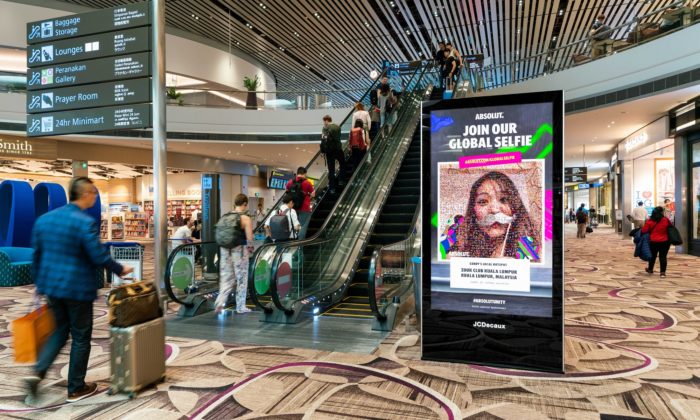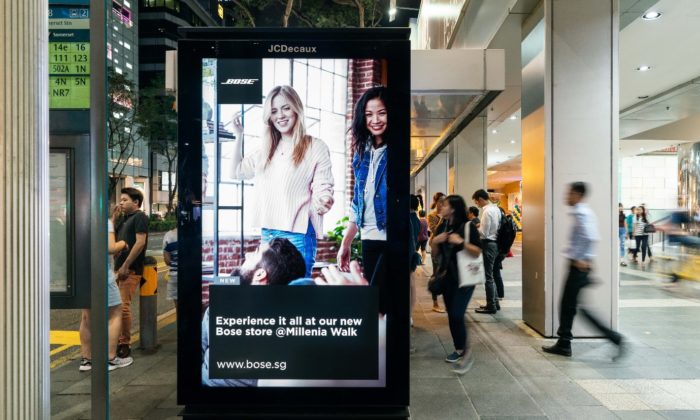
The place OOH media holds in the digital age
share on
This post is sponsored by JCDecaux Singapore.
Digital has taken over all facets of marketing and OOH is no different. In a conversation with JCDecaux Singapore's marketing and communications director, Isaline Duminil shares how with the pervasiveness of mobile devices, consumer habits have changed. Duminil explains that the issue is not in keeping consumers away from the mobile, but rather how OOH and mobile work in tandem to communicate effectively.
More here on how the OOH space has evolved with the rise of digital OOH and what clients really want from their marketing dollars spent.
With the rise of DOOH, what do you think are the expectations that clients are looking on OOH advertising?
Out-of-Home (OOH) is the most traditional form of advertising and has been effective in raising brand awareness and directing traffic to store due to its proximity to the point-of-sale. This still holds true today as OOH captures audiences in the right frame of mind to spend. According to Outsmart, OOH is the dominant medium to reach shoppers half an hour prior to purchase, what is known as the “last window of influence”.
In today’s media landscape, advertisers’ expectations have evolved with the advent of online advertising. This has brought about expectations on audience targeting, performance indicators and measuring returns when planning and executing campaigns. For greater accountability of OOH media at the airports, JCDecaux harnessed its unique global presence in five continents to develop the Airport Audience Measurement system. This new system provides a set of standardised global metrics for advertisers and agencies to estimate campaign indicators, namely unique passengers, total impressions, frequency and reach. To complement this, we are rolling out technology to help advertisers track ROI such as incremental visits, and working with advertisers on understanding the consumers’ path to purchase for optimisation.
Q Media highlights how consumers’ expectations have shifted beyond seeking information, with 61% wanting advertising to be customised to their interests and needs. This inevitably leads to boundaries of traditional media being tested. As consumers seek to be entertained and engaged, clients are challenged to develop novel ideas and enhance the customer journey through brand experiences. To meet such demands, digital OOH must provide more creative possibilities through interactive and refreshing content.
JCDecaux achieves this by using contextual ads adapted from external triggers, including weather, time, location, social feeds or custom data feeds, to deliver dynamic content on screens. Studies in the UK have shown an 18% increase in brand awareness, 12% more prompted recognition and 53% higher message recall when dynamic content was utilised. In this way, customisation of content at scale has been proven more effective in capturing the attention of audiences, driving brand awareness and ad recall, translating to increased ROI.

How can OOH advertisers keep consumers from looking at the mobile, or effective communicate with the mobile population?
Given the pervasiveness of mobile devices, the issue is not in keeping consumers away from the mobile, but rather how OOH and mobile work in tandem to communicate effectively.
An OOH Online Activation survey conducted by Nielsen revealed that OOH continues to deliver more online activity per ad dollar spent compared to other traditional media. Rapport has also reported that there was an 80% boost in search activity as a result of OOH advertising. Outdoor media accounts for 26% of gross search activations generated by traditional media, rendering it the ideal platform for brands looking to drive online traffic. It is apparent that OOH campaigns trigger an action, a desire to search and share, facilitated by the ubiquity of mobile devices.
In fact, mobile was the first media channel that integrated its advertising offer with OOH by leveraging the latter’s location-based approach to target audiences and engage consumers on multiple touch points. The widespread usage of mobile as a content creation device along with its ease of sharing on social media platforms creates opportunities for brands to gain traction through viral content on creative OOH campaigns.
There are many options to encourage interactions between mobile and digital screens, the most straightforward being QR codes, while more recent solutions leverage beacon technology connected to WeChat directly integrated in the app to trigger push notifications when the consumer passes the OOH panel.
![]()
With Singapore’s national endeavour to become a “Smart Nation”, how is JCDecaux innovating to be a “Smart Media Owner” or “Smart Advertiser”?
We are achieving this through ads with an added value to consumers and by offering extended services as actors of the city.
Innovation is in JCDecaux’s DNA, and continuous research and development drives our new solutions to
enthral audiences while offering the best value to advertisers. Our suite of solutions encompasses dynamic content powered by live data feeds to optimise campaigns and increase contextual relevance for audiences, being “smart” for consumers in that sense. These are offered on digital screens at Changi Airport, ION Orchard and bus stops along Orchard Road and the Central Business District.
Later this year, we will be inviting start-ups to leverage AI and design innovative services in the urban environment that are compatible with JCDecaux’s activities, and also enable the city to collect valuable insights. This could range from human-machine interactions to connections between citizens and the city. The aim is to continue conversations on how we can develop technological solutions for an urban lifestyle as cities like Singapore progress, as well as how these solutions are applicable on a global level.

How is programmatic going to bring OOH media owners to the next level of traditional media?
A report published recently by "Magna Intelligence and Rapport" revealed that OOH outperforms other traditional media and is the only segment to have shown consistent growth in global advertising sales over the past decade. OOH advertising revenues worldwide have been growing at an average of 4.1% over the past nine years since 2010, reaching US$31 billion in 2018. This growth has been largely due to the ability of OOH to stay relevant by implementing technology such as through creative solutions and measurement of key performance indicators.
Digital OOH represented a 37.3% share of the total OOH spend globally in 2018 and has been predicted to overtake traditional spend by 2020. While digital OOH propels growth in the industry, it is important to capitalise on this trajectory by tapping on digital screens, with programmatic media serving as a catalyst.
It is against this positive outlook that the JCDecaux group, in partnership with Veltys, launched VIOOH, a global independent automated planning and trading platform to accelerate growth of the OOH industry and connect the industry to the programmatic digital ecosystem.
The rise of programmatic presents a huge opportunity for OOH to deliver more relevant content, better audience engagement and a simplified buying process. OOH as a traditional medium still has various barriers to entry, such as spending and the buying process being primarily manual, even for large buys. By plugging OOH inventory onto Demand Side Platforms (DSPs), we are lowering those barriers, offering a consolidated platform where media planners make their media buys across different formats, including for online ads. This also allows OOH to access the share of the budget that brands allocated to digital advertising. The automation of digital OOH media is leading change in the industry by enabling a data-driven, audience-based approach to media buying.
How can programmatic in traditional media like OOH, be combined and play an effective and significant role in other forms of marketing such as retail marketing or omni-channel marketing?
In providing media planners with a consolidated platform for real-time media planning and buying, we are facilitating advertisers’ planning of touch points along the customer journey. This will also make it easier for advertisers to track attribution.
The nature of outdoor media guarantees the location of the ad as well as its delivery to an actual audience. In the current fragmented media landscape, the strength of OOH as a one-to-many medium allows it to remain unaffected by the proliferation of media channels, to reach out to the masses who are spending an increasing amount of time outside the home.
The writer is JCDecaux Singapore's marketing and communications director, Isaline Duminil. The article first appeared in Marketing’s November 2018 print edition.
share on
Free newsletter
Get the daily lowdown on Asia's top marketing stories.
We break down the big and messy topics of the day so you're updated on the most important developments in Asia's marketing development – for free.
subscribe now open in new window
